- Fact Sheet
African Immigrants in America: A Demographic Overview
Published
Immigrants from Africa constitute a highly diverse and rapidly growing group in the United States. As Census data demonstrate, the African foreign-born population doubled in size between 2000 and 2010. Nearly half of African immigrants are naturalized U.S. citizens, and seven-in-ten speak only English or speak it “very well.” Just under three-quarters of African immigrants are black, while roughly one-fifth are white. The largest numbers of African immigrants are found in California, New York, Texas, Maryland, and Virginia. The top countries of origin for African immigrants are Nigeria, Ethiopia, Egypt, Ghana, and Kenya. Two-fifths of African immigrants have at least a bachelor’s degree, and more than one-third work in professional jobs.
Between 2000 and 2010, the African foreign-born population doubled in size.
- The number of African immigrants in the United States grew from 881,300 in 2000 to 1.6 million in 2010 {Figure 1}.
Figure 1: African Foreign-Born Population in the U.S., 2000 & 2010
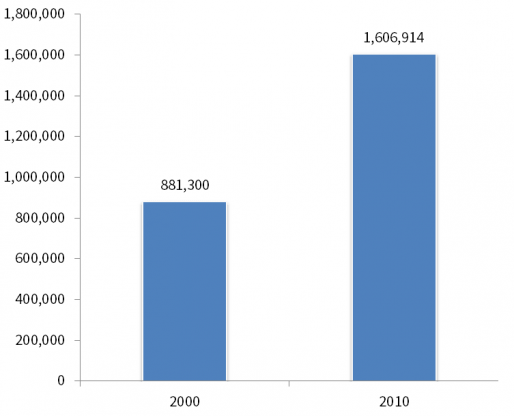
Source: Census 2000 Special Tabulations (STP-159), Table FBP-1; 2010 American Community Survey, Table S0504.
- The number of male African immigrants increased from 484,790 to 845,237 between 2000 and 2010, while the number of females increased from 396,510 to 761,677 {Figure 2}.
Figure 2: African Foreign-Born Population in the U.S. by Sex, 2000 & 2010

Source: Census 2000 Special Tabulations (STP-159), Table FBP-1; 2010 American Community Survey, Table S0504.
- In 2010, African immigrants comprised 4% of the foreign-born population {Figure 3}.
Figure 3: African Share of the Foreign-Born Population, 2010

Source: 2010 American Community Survey, Table S0504: "Selected Characteristics of the Foreign-Born Population by Region of Birth: Africa, Northern America, and Oceania."
Nearly half of African immigrants are naturalized U.S. citizens.
- 46.1% of African immigrants were naturalized U.S. citizens in 2010, compared to 43.7% of the foreign-born population as a whole {Figure 4}.
Figure 4: African Foreign-Born Population by Citizenship, 2010
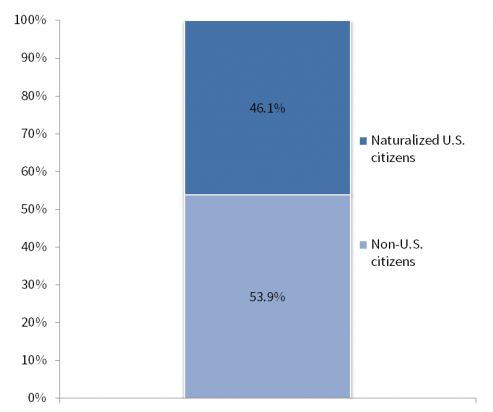
Source: 2010 American Community Survey, Table S0504: "Selected Characteristics of the Foreign-Born Population by Region of Birth: Africa, Northern America, and Oceania."
Nearly seven-in-ten African immigrants speak only English or speak it “very well.”
- As of 2010, more than one-fifth (21.8%) of African immigrants spoke only English, while just under half (49.1%) reported speaking it “very well” {Figure 5}.
Nearly three-quarters of immigrants from Africa are black, while one-fifth are white.
Figure 5: African Foreign-Born Population (Age 5 and Older) by English-Language Proficiency, 2010

Source: 2010 American Community Survey, Table S0201: "Selected Population Profile in the United States."
- As of 2010, 74.3% of African immigrants were black, while 20% were white and 2.7% Asian {Figure 6}.
Figure 6: African Foreign-Born Population by Race, 2010
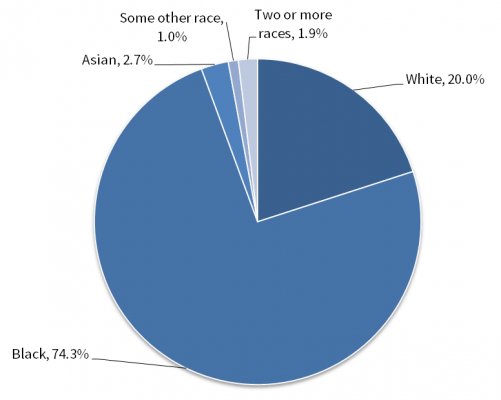
Source: 2010 American Community Survey, Table S0504: "Selected Characteristics of the Foreign-Born Population by Region of Birth: Africa, Northern America, and Oceania."
The largest numbers of African immigrants are found in California, New York, Texas, Maryland, and Virginia.
- As of 2010, the largest African foreign-born populations were in California (158,953), New York (158,878), Texas (136,112), Maryland (125,470), and Virginia (89,290) {Figure 7}.
Figure 7: States With Largest African Foreign-Born Populations, 2010

Source: 2010 American Community Survey, Table DP02: "Selected Social Characteristics in the United States."
- Between 2000 and 2010, the African foreign-born population increased in size by 111.1% in Texas, 110% in Virginia, 100.1% in Maryland, 40.3% in California, and 35.9% in New York {Figure 8}.
Figure 8: Increase in African Foreign-Born Populations in Top-Five States, 2000-2010
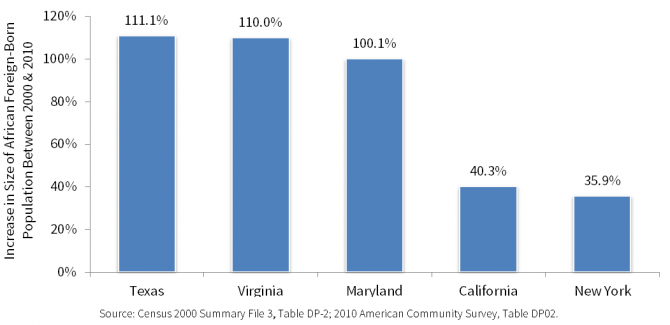
Source: Census 2000 Summary File 3, Table DP-2; 2010 American Community Survey, Table DP02.
Most African immigrants come from Western and Eastern Africa.
- As of 2010, 573,791 African immigrants came from Western Africa and 475,832 from Eastern Africa {Figure 9}.
Figure 9: African Foreign-Born Population by Region of Birth, 2010

Source: 2010 American Community Survey, Table B05006: "Place of Birth for the Foreign-Born Population in the United States." n.e.c. = "not elsewhere classified."
The numbers of immigrants from Middle Africa and Eastern Africa are growing the fastest.
- Between 2000 and 2010, the number of immigrants from Middle Africa grew by 229.8% and the number from Eastern Africa by 123.1% {Figure 10}.
Figure 10: Growth of African Foreign-Born Population by Region of Birth, 2000-2010
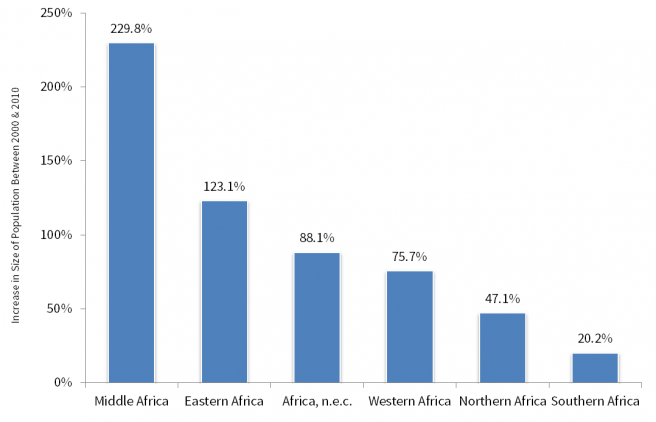
Source: Census 2000 Summary File 3, Table QT-P15; 2010 American Community Survey, Table B05006.
n.e.c. = "not elsewhere classified."
- The African immigrant groups with the largest presence in the United States as of 2010 were Nigerians (219,309), Ethiopians (173,592), Egyptians (137,799), Ghanaians (124,696), and Kenyans (88,519) {Figure 11}.
Figure 11: Top Countries of Origin for African Foreign-Born Population, 2010
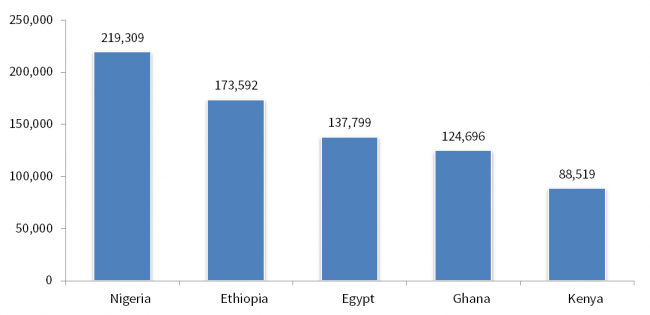
Source: 2010 American Community Survey, Table B05006: "Place of Birth for the Foreign-Born Population in the United States."
Two-fifths of African immigrants have a bachelor’s degree or more education.
- Just under one-fifth (16.1%) of African immigrants age 25 and older had a graduate degree (in addition to a bachelor’s degree) in 2010. In comparison, 10.4% of the U.S. population as a whole age 25 and over had a graduate degree in 2010 {Figure 12}.
- Nearly one-quarter (24.2%) of African immigrants age 25 and older had a bachelor’s degree only in 2010. In comparison, 17.7% of the U.S. population as a whole age 25 and over had a bachelor’s degree only in 2010 {Figure 12}.
Figure 12: Educational Attainment of African Foreign-Born Population & Total U.S. Population, Age 25 & Over, 2010
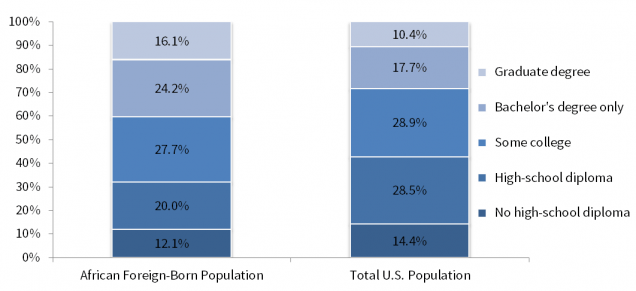
Source: 2010 American Community Survey, Table S0504: "Selected Characteristics of the Foreign-Born Population by Region of Birth: Africa, Northern America, and Oceania"; Table DP02: "Selected Social Characteristics in the United States."
More than one-third of African immigrants work in professional jobs.
- 37.7% of employed African immigrants age 16 and over worked in management, business, science, and arts occupations in 2010 {Figure 13}.
- One-quarter (24.8%) of employed African immigrants age 16 and over worked in service occupations in 2010, while one-fifth (19.8%) worked in sales and office occupations {Figure 13}.
Figure 13: Occupations of African Foreign-Born Workers Age 16 & Over, 2010
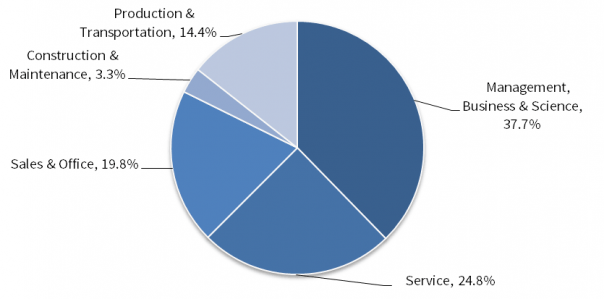
Source: 2010 American Community Survey, Table S0504: "Selected Characteristics of the Foreign-Born Population by Region of Birth: Africa, Northern America, and Oceania."
Help us fight for immigration justice!
The research is clear – immigrants are more likely to win their cases with a lawyer by their side. But very few can get attorneys.
Introducing the Immigration Justice Campaign Access Fund.
Your support sends attorneys, provides interpreters, and delivers justice.

Immigration Justice Campaign is an initiative of American Immigration Council and American Immigration Lawyers Association. The mission is to increase free legal services for immigrants navigating our complicated immigration system and leverage the voices and experiences of those most directly impacted by our country’s immigration policies to inform legal and advocacy strategies. We bring together a broad network of volunteers who provide legal assistance and advocate for due process for immigrants with a humane approach that includes universal legal representation and other community-based support for individuals during their immigration cases.

